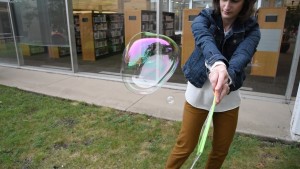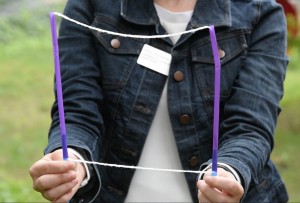The last weeks of summer are a great time to take science outside. At Skokie Public Library, we featured giant bubbles and bubble wand making at two outdoor events, one at a local school and one in conjunction with a bookmobile visit in the community. Here’s what we did.
Two staff members were present to help with setting up the supplies and to assist participants with making wands and blowing bubbles. Supplies included water, liquid dish soap, yarn or string, scissors, plastic straws, and vegetable glycerin, plus a few plastic wash tubs for mixing the bubble mixture as well as metal washers. We had a couple of homemade bubble wands available as examples for participants, made in the style of the PBS Crafts for Kids post for DIY bubble wands. We started out with a giant bubble solution using this recipe from Home Science Tools:
- Gently mix 6 cups water with 1 cup dish soap.
- Add 1 tbsp glycerin (or ¼ cup corn syrup) and gently stir until mixed.
We chose to use glycerin, which can potentially be harmful if it comes in contact with eyes, but you can use corn syrup or corn starch as a substitution.
As kids visited the activity and made bubble wands, we encouraged them to experiment with the giant bubble solution recipe, asking what they thought would happen if they added extra dish soap or extra glycerin. Participants also tested out variations of the bubble wand, trying sticks instead of plastic straws or added a metal washer to the string for added weight.
If you’re looking for a simple challenge to expand the activity, pose the question of whether wands of different shapes will create bubbles of different shapes–square wands making square bubbles, etc. As kids learn that bubbles will always be spherical, you can have kids hypothesize why and introduce the concept of surface tension.
This is a great low-cost, open-ended learning opportunity for youth of all ages. Happy bubble-making!






Leave A Comment